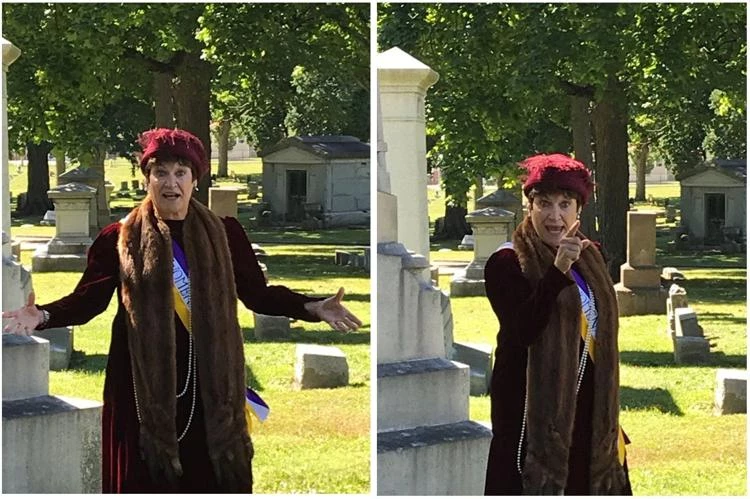The not-for-profit McLean County Museum of History celebrates local history in all its complexities and in all sorts of ways. There are exhibits, collections, lectures, school programs, walking tours, bus trips, and a whole lot more.
One unique way to explore the past is through the dramatic arts, including the museum’s popular Evergreen Cemetery Walk, normally staged each fall at Bloomington’s oldest and most historic cemetery.
Unfortunately, what with the ongoing COVID-19 pandemic, there won’t be much walking during this year’s cemetery walk. Instead, this “living history” event has been reimagined so it can still be enjoyed—albeit in a social-distancing manner from the safety of one’s home via a smartphone, tablet, laptop or PC. You’ll still get to meet the cast of historical characters and hear their stories, but instead of live, in-person theater, you’ll be watching professionally recorded performances online.
One such compelling figure you’ll get to know virtually is Florence Mae Risser Funk.
Born in Bloomington in 1871, Florence was uprooted six years later when her German-immigrant father Abraham Risser moved the family to Chicago to establish a successful saddlery business. Florence attended Vassar College in New York, and after returning to the Prairie State she married, in 1895, Frank H. Funk of Bloomington, whom she had known in her childhood.
Frank Funk was the grandson of Isaac Funk, patriarch to the large and still-influential local family line. Frank’s father, Benjamin Franklin Funk, was a former Bloomington mayor and U.S. congressman.
The newly married couple established their home at 907 N. McLean St. on the east side of Franklin Park. Their neighbor to their immediate north—the corner of McLean and Walnut streets—was Joseph W. “Private Joe” Fifer, a former Illinois governor. In 1924, Fifer’s daughter, Florence Fifer Bohrer, became the first woman elected to the Illinois State Senate.
Frank and Florence Funk were from privileged backgrounds, yet they were both committed progressives who often sided with social activists and political and economic liberals. They were a far cry from rabble-rousers or anarchists, certainly, but in their own well-mannered Corn Belt way, they fought the good fight representing the reformist wing of the Republican Party.
In Bloomington, Florence became active in all sorts of women’s societies, clubs, associations, teas, fellowships, and the like, including the Amateur Music Club, the History and Art Club, the YWCA and the Women’s Club. Faced with the enormous restrictions and limitations imposed by patriarchal America, Funk and many of her peers spurned a life of rigged domesticity, and instead devoted increasing time and energy to these social and service-oriented organizations that were beginning to address the urgent issues of the day—from public sanitation and education to suffrage.
In 1912, Frank Funk ran as the Progressive Party candidate for Illinois governor. Although a lifelong Republican, he followed former President Theodore Roosevelt, who bolted the calcified GOP to lead likeminded reformers under the banner of the Progressive “Bull Moose” Party.
As much as—or perhaps more than—her husband, Florence Funk championed progressive causes. To cite a representative example, she was active in the playground movement, as educators and welfare advocates embraced fresh air and organized play as essential to proper child development. In the spring of 1912, Funk delivered an illustrated address on playgrounds—complete with 100 slides—before the mother and parent clubs of several Bloomington schools.
In this talk, she decried the inequality when it came to educational and recreational opportunities for children in the Twin Cities. While some schools boasted well-equipped playgrounds, others lacked basic necessities. “The schools where playgrounds are most needed are most neglected,” she noted. “If playgrounds are good for some children, why not good for all.”
Funk came of age at a time when women did not have the constitutional right to vote. She was a local and state leader in the suffrage movement, serving as a delegate, for instance, to the Illinois Equal Suffrage Association convention of 1914.
When the U.S. entered the World War in 1917, Florence Funk was well positioned to help organize and lead home front efforts. The Illinois Federation of Women’s Clubs, of which Funk was vice president, helped organize Council of Defense units throughout the state. These local councils served as a principal organizing force for the statewide war effort.
Women such as Funk, noted the official history of McLean County and World War I, “were as truly, and as usefully, in the service of their country as were those who bore official titles or wore the nation’s uniform.”
After the collapse of Teddy Roosevelt’s Bull Moose Party, Frank Funk returned to the Republican fold, serving three terms in the U.S. House of Representatives. Early in his second term, Florence became gravely ill, passing away on Sep. 6, 1923, at the age of 51.
At the time of her death, she was remembered as a “woman of liberal culture, energetic nature, of comprehensive views on all questions of public interest, and possessed of a large and sympathetic heart.”
Learn all about Florence Funk and her role in the suffrage movement during this year’s Virtual Evergreen Cemetery Walk.
The McLean County Museum of History, in partnership with Illinois Voices Theatre and Evergreen Memorial Cemetery, has created another first-rate historical and theatrical experience. In addition to Funk, this year’s walk features Grace Huddleston Stewart, who fought for fair housing in the Twin Cities during the 1960s.
Household tickets are $25 (or $20 for museum members). The 26th annual cemetery walk can be viewed Oct. 3 through Nov. 2, with each ticket giving one the ability to watch all or parts of the virtual walk multiple times. Go to www.mchistory.org for further details and ticket information.

